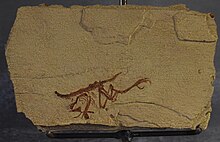Iberomesornis
| Iberomesornis | |
|---|---|

| |
| Holotype | |
| Scientific classification | |
| Domain: | Eukaryota |
| Kingdom: | Animalia |
| Phylum: | Chordata |
| Clade: | Dinosauria |
| Clade: | Saurischia |
| Clade: | Theropoda |
| Clade: | Avialae |
| Clade: | †Enantiornithes |
| Order: | †Iberomesornithiformes |
| Family: | †Iberomesornithidae |
| Genus: | †Iberomesornis Sanz & Bonaparte, 1992 |
| Species: | †I. romerali
|
| Binomial name | |
| †Iberomesornis romerali Sanz & Bonaparte, 1992
| |
Iberomesornis ("Iberian intermediate bird") is a
.Discovery
In 1985 the
The holotype specimen, LH-22, part of the Las Hoyas Collection, consists of a compressed articulated partial skeleton of an adult individual lacking the skull, the anterior neck and most of the hands. A second specimen, LH-8200, was referred to a Iberomesornis sp. in 1994, consisting of the left foot of an individual similar in size to the holotype.[3] After further preparation of the fossil, the species was redescribed by Paul Sereno in 2000.[4]
Biology and ecology

Iberomesornis was quite small, no bigger than a large modern sparrow. On the assumption it had relatively short wings, the wingspan was about twenty centimetres; its weight has been estimated at fifteen to twenty grammes. It bore a single claw on each wing. The preserved axial column length is eighty-seven millimetres. Its ribcage was not strengthened by ossified uncinate processes but cartilaginous processes were likely present.
The Las Hoyas Unit 3 site was once a forest surrounding a lake; the climate was warm with a distinct dry season. Since the skull is not known, the diet of Iberomesornis remains a subject of guesswork. It perhaps hunted insects and other small animals, plucking them out of the air or from the ground. It may have preferred to live near lakes, catching insects from the water's surface. When resting, it used its strong, clawed feet to perch on branches; the toes are long with curved claws and a low and long
Phylogeny

Iberomesornis romerali was more derived physically than
In 1992 Iberomesornis was assigned to the Iberomesornithidae. At that time it was considered to possibly have been very basal, outside of the clade Ornithothoraces, as is reflected by its generic name. However, since the discovery of Iberomesornis, many more bird fossils have come to light in the quarries of Liaoning province, China. Well preserved specimens of Chinese species such as Sinornis and Confuciusornis have permitted scientists to better understand the birds' early fossil history. Today, Iberomesornis is seen as positioned within Ornithothoraces, as a basal member of the Enantiornithes.
References
Sources
- Haines, Tim; Chambers, Paul (2006). The Complete Guide to Prehistoric Life. Canada: Firefly Books.
